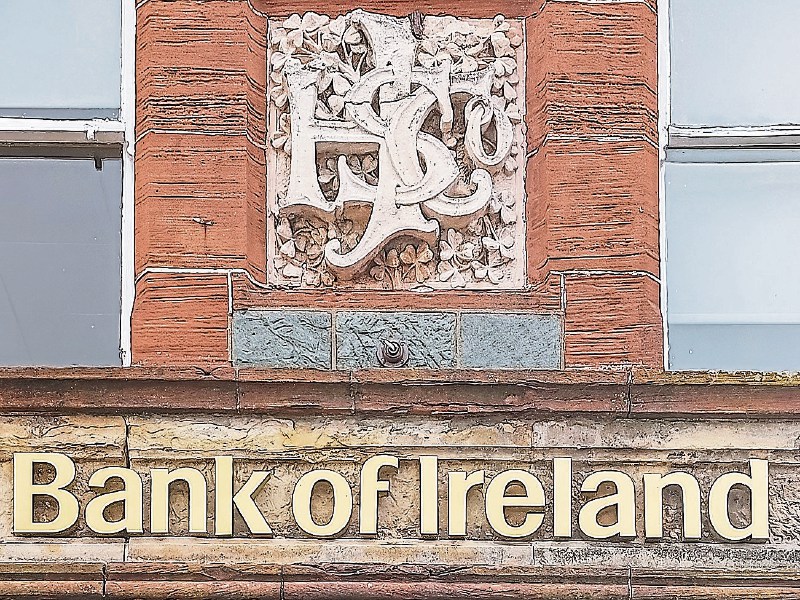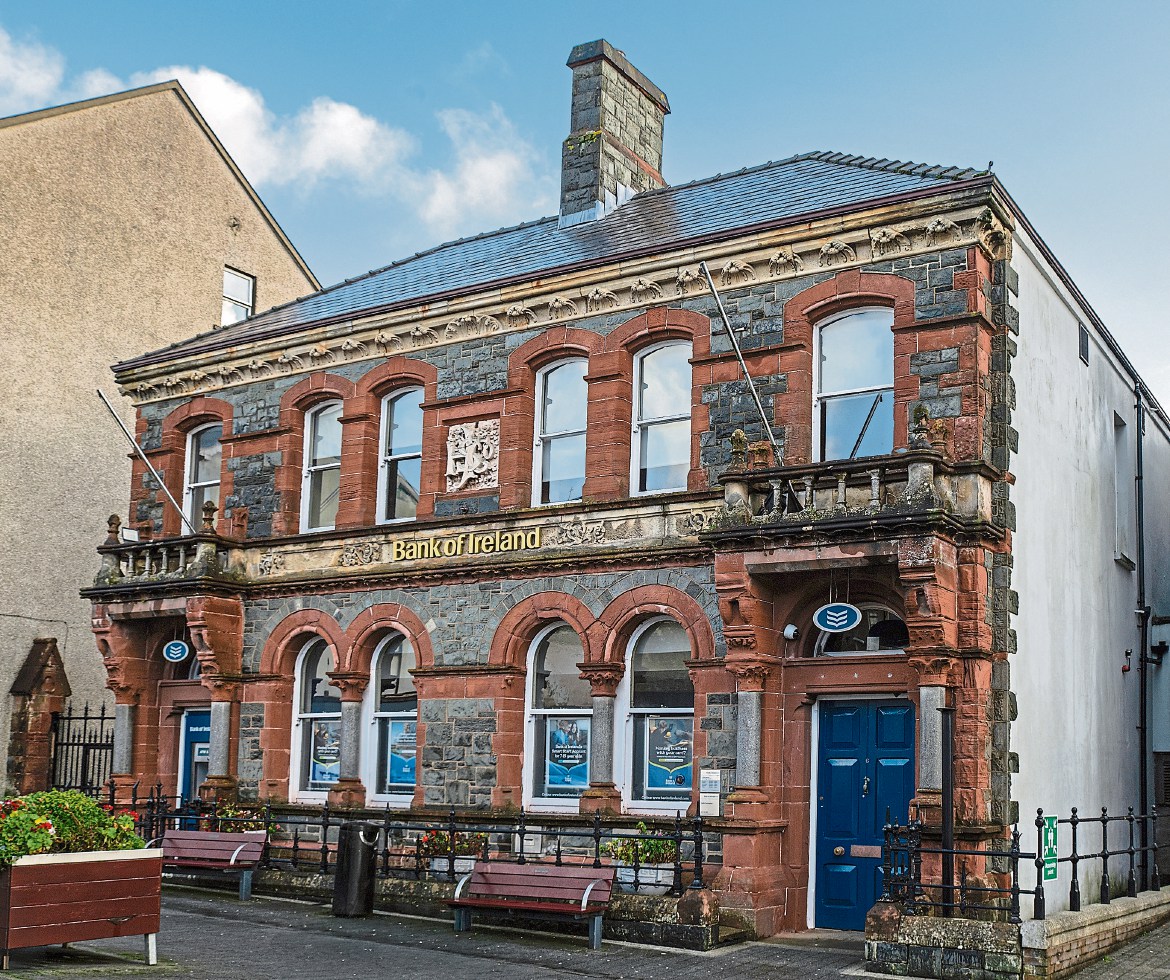By Paul Bradley
The Bank of Ireland on Letterkenny’s Main Street is not a huge building, but it has a kind of heavy grandeur that makes it one of the most memorable in the town.
It’s so firmly seen as “the Bank of Ireland” that it’s almost a surprise to learn that it was originally a branch of the Hibernian Bank, an organisation founded in 1825 to appeal to a rising class of Catholic merchants and businesspeople in Ireland.
They deliberately used architecture to project an image of solidity, wealth, and a vaguely religious character that they hoped would resonate with their target clientele (the Letterkenny branch was one of the better examples of this architectural strategy).
The foundation stone for the Letterkenny building was laid in October 1874, and it officially opened for business in 1876. The building was a major investment for the bank, with an estimated construction cost of £2,000, not including the cost of decoration.
This was a substantial sum at the time, underscoring the importance of the project to the Hibernian Bank. The main contractors were Collen Brothers of Portadown and Dublin, a well-regarded firm of the era.
The design was the work of Timothy Hevey, a Dublin-born architect and a prominent figure in Belfast’s Catholic architectural scene during the 1870s. Hevey was a prolific architect, and was commissioned for a number of projects in Donegal, including the old Literary Institute in Letterkenny, and several Catholic churches.
Perhaps his most notable work was the church at Dunlewey, not the lakeside one but the one with the round tower, which still somehow looks modern despite being built in the 1870s.
The Letterkenny building’s architectural style is often described as Victorian Gothic Revival, a popular style in the 19th century that drew inspiration from medieval Gothic architecture. Hevey’s design also had a unique flair that has been called “local rogue” architecture. It is a design, more ornate than most in the area, that was always meant to command attention and inspire confidence.
The building is a detached, two-storey structure (originally including the bank manager’s residence on the first floor, typically enough for the time), made from quality materials: basalt walls, decoratively carved limestone corbelling, sandstone quoins and Corinthian capitals. Most references to the Hibernian bank are gone now, but there’s a carved limestone plaque on the first floor bearing the monogram “HJSC” (the company’s original name was Hibernian Joint Stock and Annuity Company) which is the only surviving reference to the building’s original function as a branch of the Hibernian Bank. For over nine decades, the building served as a branch of the Hibernian Bank. However, during the 1960s a major restructuring of the Irish banking sector took place, and the National Bank of Ireland, the Hibernian Bank, and the Bank of Ireland (yes, a separate entity to the National Bank of Ireland) were merged to form the Bank of Ireland Group. This merger marked a new chapter for the Letterkenny building, as it officially became a Bank of Ireland branch in 1969.

The original Hibernian crest on a carved limestone plaque on the first floor of the building.
Over the years, the building has undergone several changes to adapt to the needs of a modern bank. A significant modern extension was added to the rear of the building. In the 1990s, some of the original architectural features were removed, including chimney stacks and finials from the apexes of the hipped roof. Most of the front facade remains largely intact, though, preserving its historic character (since it’s included in the National Inventory of Architectural Heritage it’s a protected structure).
Timothy Hevey’s links to Donegal
Timothy Hevey was a Dublin-born architect who became a prominent figure in Belfast’s Catholic architectural scene during the 1870s.
He was born in 1846 and attended St. Malachy’s College. He worked for established architectural firms before setting up his own practice in Belfast in 1869.
By 1875 he had formed a new partnership with Belfast architect Mortimer H Thompson, and was by then seen as the city’s leading Catholic architect, favoured not only by Patrick Dorrian, the Bishop of Down and Connor, but by the Bishop of Raphoe, James McDevitt. It was Bishop McDevitt who granted him several commissions in Co. Donegal, the most notable being the Church of the Sacred Heart at Dunlewey, built in 1878. Unfortunately, that same year, Hevey’s life and career were cut short: on 29 December, aged just 32, he died from congestion of the lungs brought on by a severe cold following a business trip to Newry.
The Hibernian Bank
The Hibernian Joint Stock and Annuity Company was founded in April 1825 by a group of Dublin businessmen in response to anti-Catholic discrimination by the Bank of Ireland.
Co-founded by Daniel O’Connell, the bank also aimed to serve the Quaker community, which was also excluded from the Bank of Ireland’s directorship. It opened its first branch in Dublin in June 1825, with many of its 1,063 shareholders based in London. While it was already colloquially known as The Hibernian Bank, it was only in 1885 that it officially adopted that name.
It faced challenges from the Bank of Ireland, and was forced to abandon its attempts to issue its own “token” banknotes, which were essentially promissory notes. However, it was later granted the right to issue “consolidated banknotes” in the Irish Free State in 1929. Consolidated banknotes, also known as “ploughman notes” were part of the Irish Free State’s transition to its own currency: they were issued by the eight commercial banks operating within the Irish Free State at the time, and while they were not legal tender they were redeemable for legal tender notes on demand.
The Hibernian Bank was eventually acquired by the Bank of Ireland in 1958. In 1969, the Hibernian and National Bank of Ireland officially merged with the Bank of Ireland to form the Bank of Ireland Group.
This article was carried in Thursday’s Donegal News in our Hidden from View feature – a new series of stories behind old or forgotten buildings, landmarks and places in our community










